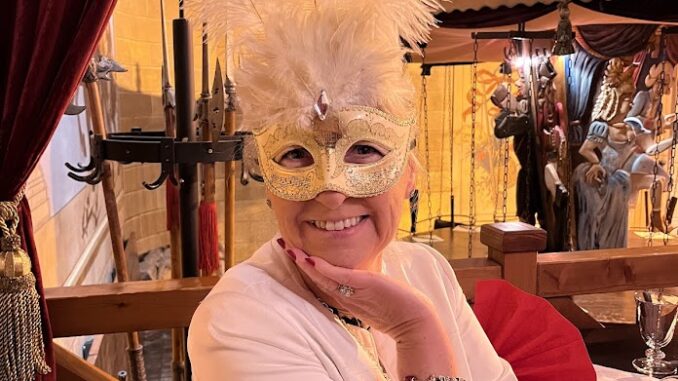
Terry has been panicking since we left Dublin Airport. He doesn’t want to be under dressed for our weekend but he doesn’t want to be over dressed either. As we pull in at the train station in Dresden I assure him not to worry. After a speedy check-in at our hotel we set off on a mission and in less than an hour we’ve our costumes covered with a wig and mask from Dieters carnival store.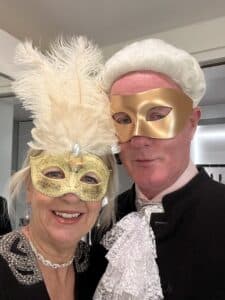
Augustus III launched the first Venetian Carnival in Dresden over 350 years ago. It was a time when the city was keen to follow in the glittering heels of the watery city of Venice to capture the spirit of romantic carnival. Like Christmas Markets, carnivals are a great excuse to explore a destination and watch how the locals like to party.
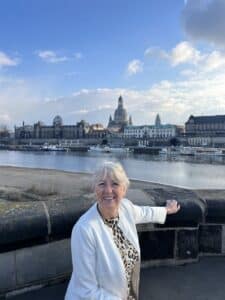
Carnival season is taken seriously in many countries with Cologne having one of the biggest in Europe. Its origins stretch back to early Christian times. A season of feasting and joviality before a time of penance during Lent associated with abstinence from meat – carne meaning meat in Latin. It’s been a green light for cultures around the globe to throw decadent parties and festivals and with the efforts of Dresden tourism and Elbevenetian Carnival the revival is well underway in Germany.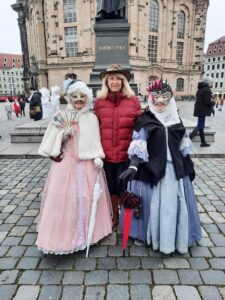
Perhaps best known for its devastating destruction during World War Two, Dresden rises like a phoenix from the ashes. Its old town has been rebuilt using the same sandstone and accurate architectural details. This was carried out with help of references, such as paintings by Belotti. He called himself Canaletto, but was actually the nephew of the famous Venetian painter of the same name.

Hanging in the Alte Meister Museum next to the Zwinger Palace and Gardens is an image of Augustus III. His adoration of Renaissance Art has left the city with an admirable collection of sculptures and paintings, the highlight being Raphael’s The Sistine Madonna. Most visitors recognise the cheeky cherubs at the base of the painting as they have been pulled from this exquisite triangular composition in the high renaissance style and reproduced in popular commercial angel imagery. 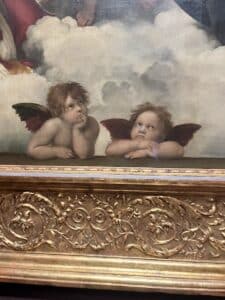 Also hanging on the gallery walls are paintings of the wealthy families that enjoyed the convenience of living in this part of Saxony close to the Austro-Hungarian Empire and Venice. It must have been a sublime time to enjoy the arts and a revival of German Baroque arts continues throughout the weekend.
Also hanging on the gallery walls are paintings of the wealthy families that enjoyed the convenience of living in this part of Saxony close to the Austro-Hungarian Empire and Venice. It must have been a sublime time to enjoy the arts and a revival of German Baroque arts continues throughout the weekend.

In 1815 Von Weber released Der Friederisk and it plays in the Semperoper house during our stay. Tickets are in high demand and we take our seats for a performance of epic proportions in this exquisite Baroque Building. Theatre Platz at the heart of the old town is now pedestrianised but facilitated by a multitude of electric trams. Indeed they run with such punctual efficiency it’s easily the best way to get around this compact city.
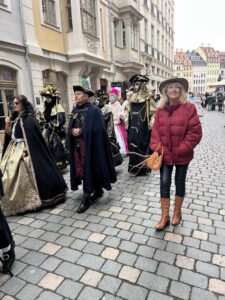
Also in the old town is Neumarkt where an effigy of Martin Luther stands in front of the cathedral and it’s where we meet the procession of Elbvenetian Carnival next morning. The square is quiet at first with just the dong of a bell but slowly floating in fine baroque regalia characters step out of the side streets and shadows. This is only the second year of the festival proper but small groups have been gathering and dressing up in traditional costumes for four years in preparation for this, the 350 anniversary of Elbvenetian Carnival.
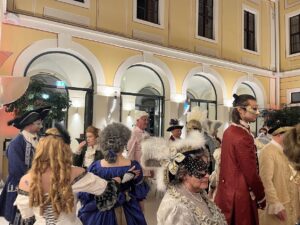
Although the carnival is in its infancy it has the potential to become a fanfare of fun for years to come. We follow the parade and get chatting to a couple of finely dressed ladies who tell us that it has taken them the guts of nine months to make and sew their costumes. It’s a truly fascinating stroll through the city that stops off in the palace and we enjoy a spot of lunch in Ana’s restaurant. Afterwards we take a tour through the armoury and observe portraits of the Holy Roman Emperors. Enormous swords and horse armour fill the cabinets as well as a fine collection of renaissance clothing to rival the Victoria and Albert Museum in London.
That evening an elegant ball is held in The Bilderburg Bellevue Hotel, and we get the chance to partake with our own masks and feathers. The banquet is followed by demonstrations of Baroque Dances and we step out with the experts as the evening progresses. We don’t exactly stand on toes but we have a bit of trouble keeping up with those who have been dancing through the streets of Dresden earlier.

It helps to hone your inner camp and throw yourself into the festival in Dresden. There’s nowhere better to do this than at Carte Blanch, a spectacular cabaret that offers Burlesque and Drag Show’s accompanied by dinner. For the festival there’s a Sunday Lunch option to dress up in full baroque fashion and join the talented singers on stage. If you don’t speak German the comedy segment will go over your head but the dancing and performing is enjoyable and audience participation is encouraged throughout the show.
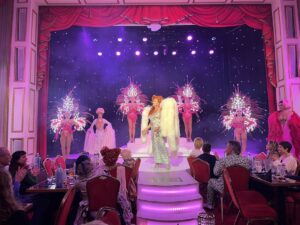
We found some cosy bars during our stay, notably the Red Rooster Bar – only a stone’s throw from our hotel. If you go don’t be surprised to find a smoking zone in the bar. For tapas, El Espanol was a good choice on our last night. Getting around the city use a city pass, walk or jump on a tram. Although there are no direct flights from Ireland to Dresden it’s easily accessed by train. We flew in from Prague and out from Berlin and being placed roughly between the two, Dresden’s an ideal destination for an extended city break from either city.
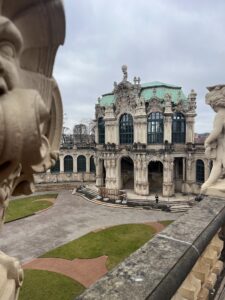
We came home with our wigs, feather boas and masks intact and the notion that perhaps we should make carnival a yearly tradition!

Factbox
For all you need to know about Germany see www.germany.travel
Flights to Berlin and Prague from Dublin with ryaniar.com and aerlingus.com
Michelle stayed at the www.bilderberg-bellevue-dresden.de/ in an excellent location close to the city centre.
To learn more about the Elbe Venetian Carnival see www.elbvenezianischercarneval.de

